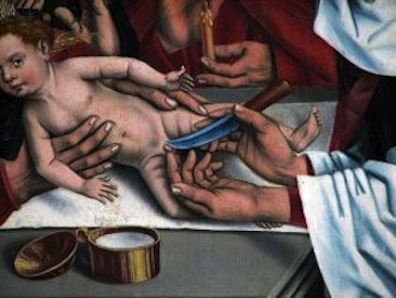"To whom?... Ah, to be sure!... The islanders, Mulligan said
to Haines casually, speak frequently of the collector of
prepuces." Adopting the persona of an ethnographer detailing
the exotic cultural practices of his countrymen to a visiting
colleague, Mulligan explains their belief in a strange deity
who judges the loyalty of his followers by their willingness
to slice rings of skin off the genital organs of their infant
male offspring. Joyce no doubt wishes to offend Irish
Catholics, but he may also be setting his sights higher: on
the Holy Father and his conclave of cardinals in Rome.
In Ithaca, Stephen too thinks of circumcision,
while urinating with Bloom in Bloom’s back yard. Exposed
penises make the scientific Bloom think of issues like
“tumidity," "sanitariness," size, and hairiness, but they turn
Stephen’s mind to the circumcision of Jesus Christ, and
particularly to the question of “whether the divine
prepuce, the carnal bridal ring of the holy Roman catholic
apostolic church, conserved in Calcata, were deserving of
simple hyperduly or of the fourth degree of latria accorded
to the abscission of such divine excrescences as hair and
toenails.” Gifford glosses the question posed by
the dual nature of Christ: "is this relic a part of the body
of Jesus, in which case it is due latria, the highest kind of
worship, paid to God only . . . or is the relic 'human,' thus
meriting hyperdulia, the veneration given to the Virgin Mary
as the most exalted of human beings?" (586).
Christ’s foreskin, the only part of the divine body left
behind on earth (not counting hair, sloughed skin,
fingernails, and toenails), was indeed regarded not only as a
holy relic, but as a “carnal bridal ring.” A book by David
Farley, An Irreverent Curiosity: In Search of the
Church’s Strangest Relic in Italy’s Oddest Town (2009)
notes that Catherine of Siena, the medieval saint, was
reported to have worn her Lord’s foreskin as a ring around her
finger. In doing so she was probably following the practice of
many medieval female religious of becoming quite literally
married to Christ—a phenomenon explored in Sarah McNamer’s Affective
Meditation and the Invention of Medieval Compassion
(2009). Later, though, the sacred penis part ended up in the
north Italian hill town of Calcata, making the town’s church
an important pilgrimage destination. Farley’s adventure story
starts from the fact that, in December 1983, the church’s
parish priest announced to his congregation that the foreskin
of Jesus had disappeared.
In addition to confirming what Stephen says about bridal
rings and about Calcata, Farley’s book discusses something
that is never mentioned in Ulysses but that may very
well account for Mulligan’s and Stephen’s strange
obsession. Although the divine foreskin had been an
object of veneration for many centuries, and at one point
belonged to the Vatican, Calcata’s long history of marketing
it to pilgrims excited embarrassment and other ill feelings
(penis envy?) among the princes of the church, and changes in
Catholic theology made veneration of divine genitals more
problematic than it had previously been. In 1900, therefore,
the Vatican decreed that the parish could display its prize
holding only on New Year’s Day. It declared, furthermore, that
from that day forth anyone who spoke about the divine foreskin
would be subject to excommunication. Given the fact that Joyce
is up to speed on other aspects of the divine prepuce, it
seems likely that he would have known about this papal ban. If
so, he is making a point of spectacularly defying it, once in
Telemachus, again in Scylla and Charybdis,
and most volubly in Ithaca.

